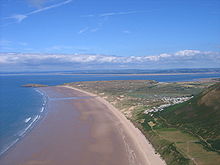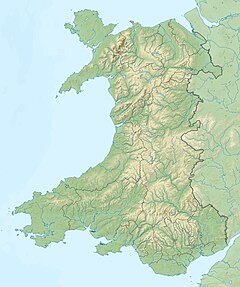River Loughor
| River Loughor | |
|---|---|
 River Loughor just above the Loughor bridges | |
| Native name | Afon Llwchwr |
| Location | |
| Country | Wales |
| Counties | Carmarthenshire Swansea |
| Physical characteristics | |
| Source | Black Mountain |
| • location | Llygad Llwchwr |
| Mouth | Carmarthen Bay |
• location | Loughor |
• coordinates | 51°40′N 4°05′W / 51.667°N 4.083°W |
The River Loughor (/ˈlʌxər/[1]) (Welsh: Afon Llwchwr) is a river in Wales which marks the border between Carmarthenshire and Swansea. The river is sourced from an underground lake at the Black Mountain emerging at the surface from Llygad Llwchwr which translates from the Welsh as "eye of the Loughor". It flows past Ammanford and Hendy in Carmarthenshire and Pontarddulais in Swansea. The river divides Carmarthenshire from Swansea for much of its course and it separates Hendy from Pontarddulais at the point where the river becomes tidal. The Loughor meets the sea at its estuary near the town of Loughor where it separates the south coast of Carmarthenshire from the north coast of the Gower Peninsula. Among its tributaries is the River Amman and the River Morlais, with the former joining the Loughor near Pantyffynnon. The area of the catchment is some 262 square kilometres (101 sq mi).[2]
In the 18th century, the river was a noted salmon and sea trout river. Fish from the river was then carried on ponies to be sold at Swansea Market. The fishing declined in the 19th century due to increasing pollution from industrialisation.
Carmarthenshire County Council is currently[when?] undertaking studies into the possibility of constructing a barrage across the River Loughor upstream from the Loughor bridges.[citation needed]
Estuary

| Designations | |
|---|---|
| Official name | Burry Inlet |
| Designated | 14 July 1992 |
| Reference no. | 562[3] |
The Loughor Estuary (aka Burry inlet or Burry estuary, from the small Burry River which enters on the Gower side near its mouth) is the region of the waterway below the road and rail bridges at Loughor, where it turns abruptly from a southerly to a westerly direction towards Carmarthen Bay. The Afon Lliw empties into the estuary just below the Loughor bridges. This region almost completely empties at low tide, exposing extensive sandy areas supporting a thriving cockle industry.
On the south side of the inlet, the gathering and processing of cockles (
The estuary cuts through the southern part of a once-important coalfield. Llanelli, on its north shore, was noted for its tinplate industry, whilst Penclawdd, on the south side, smelted copper from ore shipped in from Anglesey. Both required ready access to the Bristol Channel via Carmarthen Bay. The main channel has fluctuated from side to side of the estuary in the past; in the late 19th century, the Llanelli Port Authority obtained legislation permitting the construction of a training wall intended to confine it to the north side of the estuary; unfortunately, this merely dissipated the currents, accelerating the silting-up not only of the entrance to Llanelli North Dock but also of the Penclawdd anchorage. The wall has since been breached in several places.

A later influence on the physical environment was the planting of cordgrass (
The estuary is partly closed off by Whiteford Point, which extends from
During
See also
References
- ^ G.M. Miller, BBC Pronouncing Dictionary of British Names (Oxford UP, 1971), p. 92.
- ^ "First Water Resources Survey : Report", South West Wales River Authority, Published 1970, Page 41; Table 1
- ^ "Burry Inlet". Ramsar Sites Information Service. Retrieved 25 April 2018.
- ^ "Anthrax (Hansard, 29 January 1987)". Parliamentary Debates (Hansard). 29 January 1987. Retrieved 2 June 2015.
Sources
- Problems of a Small Estuary, ed. A. Nelson-Smith & E.M.Bridges, Institute of Marine Studies (University College, Swansea) & West Glamorgan County Council, Swansea, 1977.

